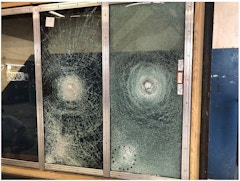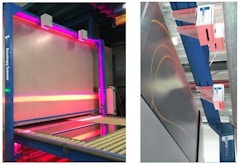
169 results
-
 Glass by nature is a reflective material, and it is well-known and documented that issues of glare can occur due to solar reflection. This phenomenon…
Glass by nature is a reflective material, and it is well-known and documented that issues of glare can occur due to solar reflection. This phenomenon… -
Laminated Security Glazing
- Paper by Vaughn Schauss
Glass is an essential component for any type of building. Its transparency enhances daylighting and provides occupants a view to the outside. Whether
-

Design Considerations
- Paper by Stephen M. Morse, Ph.D. · Kayla Natividad, Ph.D. · H. Scott Norville, P.E., Ph.D.
Window glass design using ASTM E 1300 entails determining glass thickness(es) and types so that the window glass construction load resistance
-

Subjective Perception and Objective Measurement
- Paper by Caroline Lama, Antonio Luz, Ashley Reed,
Current glass industry standards provide clear tolerances for readily quantifiable physical properties to assist with the evaluation of visual… -

The Seismic Capability of Curtainwalls
- Paper by Peter Lalas MIEAust CPEng NER APEC Engineer IntPE(Aus), Principal Facade Engineer
The testing of aluminum/glass curtainwalls for seismic capability, mainly inter-story drift, has been carried out on many curtainwalls over the last… -

Transparent Aerogel Window
- Paper by Bryan Toton, ENV SP, CEO
Incorporating a novel, transparent monolithic aerogel into insulated glass units (IGUs) for windows and building enclosures will provide the… -

Integrating Structure and Cladding
- Paper by Jerome Engelking, Christian Stutzki, Principal
The project represents a successful integration of a glass facade with the primary structure of the building. The choice of the building material is… -

Case Study: Kao Ho Hospital Development, Kaohsiung, Taiwan
- Paper by Jerry Ma · Jason JS Lin
U-shaped annealed profiled glass, or U channel glass is used in both the interior and exterior glass façade for decades, as it has long and durable
-

Lightweight Veneer in High-rise Unitized Facades
- Paper by Michael Chen, P.E., Principal Antonio Luz, R.A., Senior Associate
Manufactured veneer panels such as glass fiber reinforced concrete (GFRC), ultra high performance concrete (UHPC), sintered stone, and terracotta are… -
Creating Transformational Geometry
- Paper by Tom Peterson, System Designer Manager Austin Bensend, PE, SE, Director - Design Engineering
Over the past two decades, the art of cold-forming glass has grown from an unknown approach to a widely accepted strategy for achieving an array of… -

Glazing Design By ASTM E 1300
- Paper by H. Scott Norville, P.E., Ph.D., F. FTI, F. ASCE, F. ASTM, Professor Stephen M. Morse, P.E., Ph.D., A.M, ASTM, Assistant Professor of Civil and Environmental Engineering James G. Soules, P.E., S.E., P.Eng., SECB, F. SEI, F. ASCE, Graduate Student, Department of Civil, Environmental, and Construction Engineering
ASTM E 1300 “Standard Practice for Determining Load Resistance of Glass in Buildings” defines the load resistance of a glass construction as being… -

Advances in Effective Thickness
- Paper by Adam J Nizich, P.E., Senior Consulting Engineer Andrea M. La Greca, P.E., Consulting Engineer Laura Galuppi, PhD, Assistant Professor of Solid and Structural Mechanics
Effective thickness is a simplified method for the structural evaluation of laminated glass section properties. The method consists of defining the… -

Go Big or Go Home!
- Paper by Patrick Loughran, FAIA, PE, LEED AP, Richard Barrett, AIA, Senior Associate
This paper will focus on the design and detailing of large-format glass enclosures intended to maximize transparency using state-of-the-art materials… -
Blast Performance of TSSA
- Paper by Jon H. Kimberlain · Lawrence D. Carbary
Architectural preferences for commercial building continue towards increased transparency resulting in large lites of glass with minimal visual
-

Fixed Edge Supports
- Paper by James G. Soules, Ph.D., P.E., S.E., P.Eng., SECB, F.SEI, F.ASCE, Visiting Scholar Stephen M. Morse, Ph.D., P.E., M.ASCE, Assistant Professor Scott H. Norville, P.E., Ph.D., Professor
Model building codes and standards in the United States use a probabilistic model to define glass load resistance (LR). In general, these model… -

CR∆CKİNG THЄ CDЄ // DYN∆MİC L∆B F∆C∆DЄS
- Paper by Amanda King, AIA, LEED AP BD&C, CPHC, Dayita Kumar, LEED GA, Associate Daniel Nauman, AIA, NCARB, LEED AP, CPHC, Senior Associate
The real estate market continues to demand “all glass” buildings often to the detriment of human comfort and thermal performance. For an office… -

Hurricane-acoustic Glazing Barriers Using New Interlayer Technology
- Paper by Stephen J Bennison, B.Sc., M.S., Ph.D. · Alejandro G Gonzalez · Charles Anthony Smith · Rebecca L Smith · Takuya Kobayashi · Toshiyuki Iguchi
In the last twenty years we have seen the development of polymer interlayers for laminated glass where the resin compositions have been optimized for
-
Anisotropy and Haze Measurement with Online Scanners
- Paper by Rainer Feuster
Architects and facade planners require that anisotropies or haze, optical phenomena disturbing the clear appearance of a glass, have to be avoided
-

Simplicity is Deceiving
- Paper by Giovanni De Mari, BSc(Hons) MScEng Ing CEng MICE, Senior Engineer Kerry Hegedus, architect (WA, AZ), architect, senior associate
The case study presented is a 195 meters tall office tower with a raised podium made of 16 meters full height glass panels (and smaller). The panels… -

Case Study: Renovation of Fountain Place
- Paper by Alfonso Lopez P.E., Principal and CEO David Dunham P.E, Director of Business Development Diarmuid Kelleher P.E., S.E., Director of Engineering
Fountain Place is a project that exemplifies the latest technology and applications in building skin design and jumbo structural glass applications,…

